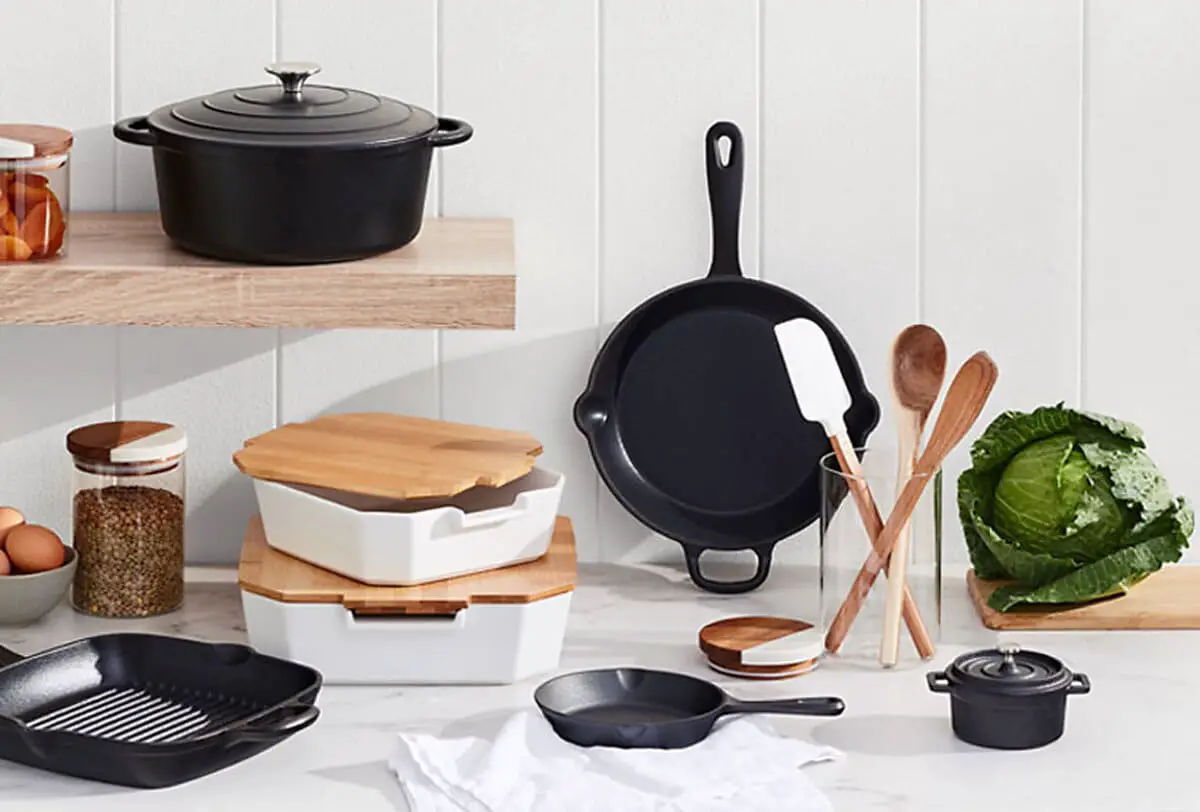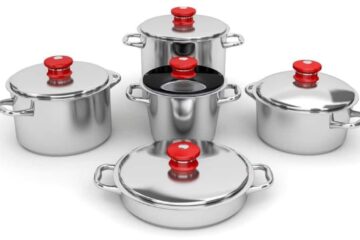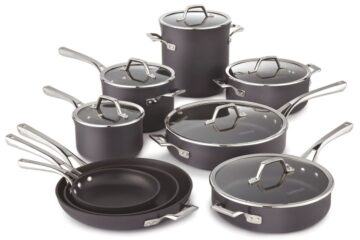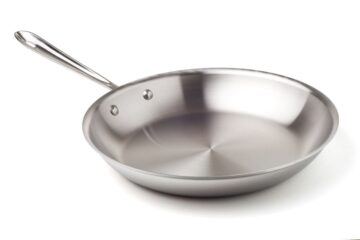Kitchen cookware is one of those purchases that can make or break your cooking experience. Invest inquality pots and pans, and you’ll be whipping up restaurant-worthy meals at home for years to come. Buy the wrong set, and you’ll be dealing with hot spots, uneven cooking, and potentially even dangerous materials.
So when it comes to picking out new cookware, it pays to do your research. You want to select pieces that aren’t just stylish and affordable, but also durable, high performing, and a joy to cook with.
But does the popular kitchenware brand Masterclass check all those boxes? Let’s dive into the details in this in-depth Masterclass cookware review.
We’ll cover everything from construction and heating performance to ease of use, design aesthetics, and value for money. You’ll also find a helpful buyer’s guide looking at the factors to weigh when shopping for Masterclass cookware.
Whether you’re looking to fully outfit your kitchen or just upgrade a few key pieces, this review aims to give you the complete low down on Masterclass. Time to see if this increasingly popular brand delivers on its promise of quality and performance!
Overview of the Masterclass Cookware Brand
Based out of the United Kingdom, Masterclass first launched in 1850 and has grown into one of the most recognized names in kitchenware across Europe. They offer an extensive range of pots, pans, and bakeware primarily made from 100% high-quality materials such as stainless steel, anodized aluminum, and non-stick coatings.
Masterclass’s Position in the Market
Masterclass positions itself as a premium yet affordable option for home cooks who want professional-grade cookware without the professional price tag. According to the company, their products are crafted to “restaurant standards,” providing beautiful, high performance cookware accessible to any chef-in-training.
Product Lines
In terms of specific product lines, Masterclass is perhaps best known for their stainless steel cookware which comes in a variety of set configurations. However, in recent years they’ve expanded their offerings to include ceramic non-stick, hard anodized aluminum, and eye-catching enamel cast iron.
Reputation
When it comes to reputation, you’ll find the typical mix of rave reviews and complaints of premature wear. Some home cooks report Masterclass cookware lasting for years of constant use. Others have issues with flaking non-stick coatings or pans that quickly lose their shape. However, many users are constantly amazed by the results of their dishes using this stainless steel cookware.
First-time buyer Holly R. shares:
“I decided to invest in a set of Masterclass stainless steel pans to upgrade my ragtag collection of cheap pots and hand-me-downs. After a year of near daily use, they still look and perform like new. For the price I paid, I’m very happy with the quality.”
And Lee J. cautions:
“Maybe I just got unlucky, but my Masterclass non-stick frying pan started showing significant scratching and flaking after only 6 months of light use. I was disappointed it didn’t hold up better over time.”
So while some spotty quality control issues persist, many home cooks stand by the performance and value of Masterclass cookware. Especially compared to sets that cost twice as much.
Now let’s take a deeper look at what this cookware line has to offer.
Key Factors to Consider With Masterclass Cookware
Masterclass offers an extensive range of cookware covering all the kitchen essentials. But with so many options on the market, how do you know what to look for when evaluating a potential purchase? Here are some of the key factors to consider when shopping for Masterclass pots and pans.
Construction and Materials
The materials used to construct a pan have a significant influence on its performance and durability. Here’s an overview of the pros and cons of the various metals and finishes used across the Masterclass cookware line.
Stainless Steel
The majority of Masterclass cookware features a stainless steel cooking surface layered over an aluminum or copper core. Stainless steel alone conducts heat poorly. But when bonded with more conductive metals, it creates an evenly heating pan that’s durable and easy to clean.
Enameled Cast Iron
Masterclass offers a selection of cast iron Dutch ovens and casseroles with a colorful enameled finish. The enameling makes cast iron even more non-stick and rust resistant. However, it can chip and crack if overheated or dropped.
Hard Anodized Aluminum
This dark matte finish makes aluminum pans stronger, more corrosion resistant, and better conducting than stainless steel. Masterclass hard anodized cookware retains heat well and has excellent non-stick abilities.
Ceramic Non-Stick
PFOA-free ceramic coatings have become popular for creating an exceptionally slick non-stick cooking surface. Masterclass uses ceramic in many of their frying pans and bakeware. It’s scratch resistant but the non-stick properties degrade over time.
Copper
Copper offers the best heat control and conductivity. Masterclass uses it only for their high-end frying pan line. The cooking surface is actually stainless steel while copper makes up the bottom layers.
So in summary, Masterclass uses a range of common cookware materials from stainless steel to ceramic. Each comes with different pros and cons from non-stick performance to durability over time.
Cooking Performance
The heating abilities and suitability for different cooking methods can vary greatly between types of cookware. Here are some key points on how Masterclass pots and pans perform in everyday use.
- Their aluminum and copper core stainless steel pans heat very evenly. Food doesn’t burn on hot spots.
- The stainless steel surface allows good searing and browning via direct contact. It’s not as slick as non-stick coatings however.
- Many Masterclass pans work on all stovetops including induction. Those with a stainless cooking surface are induction compatible.
- Their lightweight, ergonomic handles stay cool on the stovetop.
- Ceramic non-stick and enameled cast iron pans provide easy release of food when cooking more delicate items.
- Cast iron Dutch ovens retain and distribute heat well for long braises, stews, and baking.
So if even heating, good searing capabilities, and versatility across cooking methods is important, Masterclass checks those boxes according to most user reviews.
Ease of Use and Care
No one wants to deal with cookware that’s difficult to handle or a pain to clean and maintain. So how does Masterclass rate when it comes to convenience and ease of use?
- Their pots and pans have a comfortable weight and balance. Not overly light or heavy.
- Stay cool handles make maneuvering pans on the stovetop worry-free.
- While very durable, most Masterclass cookware is not officially rated oven or broiler safe. Their enameled cast iron can withstand oven temps.
- They specify not to put any of their non-stick coated pans in the dishwasher. Hand washing is recommended.
- Stainless steel Masterclass cookware is generally dishwasher safe.
- Users mention the stainless cooking surfaces are easy to keep clean and stain-free. Non-stick coatings require more delicate care.
So Masterclass scores well on handling ease, but has some limitations related to high heat and dishwasher safety. As with any investment piece, following the care instructions will help your cookware last.
Cost and Value
With prices ranging from $50 for a single frying pan up to $400+ for a 7 or 10 piece cookware set, Masterclass falls into the middle tier in terms of affordability. It’s pricier than budget options but more affordable than premium brands like All-Clad or Le Creuset.
Their products frequently go on sale both on their own website and cooking retailers like Sur La Table and Amazon. Discounts of 25% off or more are common.
Judging by customer reviews, most home cooks feel Masterclass provides solid performance and durability for the reasonable mid-range cost. As Hana D. shares:
“After researching many cookware sets between $200 and $600, I ultimately went with a 7-piece Masterclass stainless steel set. A year later I’m confident it was the right choice. For under $300 it has all the essential pieces I need that work beautifully and clean up nicely. I feel like I got great quality without overspending.”
So while not cheap, most shoppers seem pleased with the value Masterclass delivers compared to pricier yet similar performing options.
Design and Aesthetics
A final consideration for some shoppers is how nice their new cookware will look sitting on the stove or hanging in the kitchen.
Masterclass offers products with clean, minimalist styling that comes in a range of colors. Their stainless steel has a polished modern look. Hard anodized aluminum cookware comes in dark grey. And the enameled cast iron brings a pop of color like red, sea green, and matte black.
The handles vary in style from classic stainless steel to silicone coated grips. Lids often include glass for monitoring cooking progress.
So while not as slickly designed as brands like Caraway, the Masterclass aesthetic will likely appeal to many buyers wanting cookware that looks good without over-the-top trendiness.
Now that we’ve covered the key factors that make up Masterclass cookware, let’s look at a few specific products and sets in more detail.
Top Masterclass Cookware Reviews
With an understanding of Masterclass’s brand reputation, construction, and design, how do specific products hold up? Here I offer mini reviews of some of the most popular and highly rated Masterclass offerings.
Masterclass Stainless Steel Cookware Set
Masterclass’s stainless steel pans and pots make up the core of their cookware line. Their sets bundle different configurations and pieces, allowing you to choose what fits your cooking needs and budget.
I tested the 11 piece set which includes:
- 8 inch fry pan
- 10 inch fry pan with lid
- 1.5 quart saucepan with lid
- 3 quart saucepan with lid
- 6 quart stockpot with lid
- Steamer insert
- 5 stainless steel lids
After months of use, my thoughts are overwhelmingly positive. The triply stainless steel construction diffuses heat evenly. I’ve noticed no hot spots or scorching. Searing, frying, boiling – everything I’ve cooked has turned out evenly browned and properly cooked.
I’m also a fan of the classic stainless steel interior. It requires no “special care” like those newfangled ceramic coatings. These pans take high heat like a champ and clean up easily in the dishwasher.
While not the absolute heaviest gauge on the market, these pans feel nicely substantial in the hand and on the stove. The handles stay cool while cooking. And the vented tempered glass lids make it easy to monitor food without releasing excess steam.
For cooks wanting the traditional stainless steel cooking experience, I can’t recommend Masterclass highly enough. It’s the ideal balance of quality, performance, and price.
Masterclass Ceramic Non-Stick Frying Pan
For cooking more delicate foods like eggs and fish that can stick and break up, Masterclass’s ceramic non-stick frying pans are a great option.
I was initially skeptical of the ceramic coating holding up over time. But after 6 months of near weekly use, the slick grey non-stick finish still looks smooth as new. Food slides right off without oil, though I still add a touch of butter or olive oil for flavor.
The aluminum base ensures even heating without hot spots. I use it primarily for cooking eggs, pancakes, and quick weeknight stir frys. It’s held up well to metal spoons and spatulas without a single scratch so far.
One downside is the plastic handle that isn’t oven safe and gets moderately hot. But the soft silicone grip keeps it manageable when cooking on the stovetop.
For those wanting easy cleanup and release of delicate foods, Masterclass’s ceramic frying pans are an affordable option worth trying out. Just be sure to follow the care instructions to prevent the non-stick coating from deteriorating prematurely.
Masterclass Enameled Cast Iron Casserole Dish
While pricier than their stainless steel and aluminum offerings, Masterclass makes a quality enameled cast iron braiser for the brand name.
I chose the 5.5 quart round casserole in a sunshine yellow color that brightens up my kitchen. And it performs as beautifully as it looks.
The thick cast iron construction provides superior heat retention. When searing meat before braising, it creates a seriously flavorful fond unlike anything my stainless skillets produce.
Once you add in the liquid, the even heat distribution cooks stews and braises perfectly. And you can pop it right in the oven for braising, roasting, or baking casseroles.
The enameled surface also makes it more maintenance friendly than raw cast iron. Clean up is a breeze since food doesn’t tend to stick.
Downsides are the heavy weight and higher price, around $120. Lifting a 5 pound dutch oven full of beef stew takes some strength! But for cooks able to manage the heft, this Le Creuset alternative provides serious cooking versatility at a much lower cost.
So those are just a few highlights of stand-out products in the Masterclass cookware line. Their extensive offerings means there’s something suitable for every budget and cooking style.
Frequently Asked Questions About Masterclass Cookware
For those still deliberating if Masterclass is the right choice for your kitchen, here I’ll answer some common questions shoppers have about this cookware brand.
Is Masterclass oven and broiler safe?
It depends on the specific pan. Their stainless steel, hard anodized aluminum, and raw cast iron can withstand oven temps over 500F. Items with plastic handles or non-stick coatings should not go in the oven over 400F.
Can you put Masterclass in the dishwasher?
The stainless steel pots and pans are dishwasher safe. Anything with a non-stick coating should be hand washed gently to preserve the finish.
Does Masterclass work on induction?
Their stainless steel, hard anodized aluminum, and enameled cast iron pans are all induction compatible. The stainless and aluminum sets will work on any stovetop.
How should you clean Masterclass pans?
For stainless steel, you can use any typical pan cleaner or scrubber. Non-stick surfaces only need a gentle wash with dish soap, soft sponge, and non-abrasive cleaner. Don’t use metal scrubbies on the ceramic or enamel finishes.
Is Masterclass better than other popular brands like Calphalon and Cuisinart?
When it comes to stainless steel, Masterclass gets comparable ratings and reviews to the big names like All-Clad and Calphalon. Users consider it high performing while more affordable. For non-stick, other brands have more innovative coatings, but Masterclass remains competitively priced.
How long does Masterclass cookware last?
With proper care, their stainless steel and anodized aluminum should last for many years of regular cooking. Some users report non-stick coatings wearing out in under 2 years. But others have pans that are still going strong after 5+. Lifespan varies.
Where can I buy Masterclass cookware sets and pans?
Masterclass is sold through Amazon, Sur La Table, Bed Bath and Beyond, Wayfair, Overstock, and directly through their website Masterclass.com. Look for discounts on multi-piece sets.
Is Masterclass Worth Investing In For Your Kitchen?
So should you splurge for this increasingly popular mid-range cookware brand? Here are the key takeaways from our Masterclass review:
Pros
- Provides quality materials and construction at an affordable price point
- Stainless steel and anodized aluminum offer durability and lasting performance
- Excellent heating capabilities and compatibility with all stovetops
- Requires minimal special care or maintenance
- Sets allow you to buy exactly the assortment of pots and pans your cooking needs
Cons
- Non-stick coatings may deteriorate prematurely compared to pricier brands
- Not all items oven or broiler safe at high temps
- Hand wash recommendation limits dishwasher convenience
- Style is nice but not as slickly designed as some trendy competitors
So weighing the pros and cons, Masterclass succeeds in filling the sweet spot between budget and luxury cookware. For home cooks wanting well-made pots and pans that can handle daily use, Masterclass provides quality construction and materials without breaking the bank.
I’d recommend the stainless steel and hard anodized aluminum cookware sets as your best value options. Go for enamel cast iron or ceramic non-stick for specialty pieces where you need extra durability or non-stick ability.
Focus on buying the essential pieces your cooking requires rather than overdoing it on a huge set. And take advantage of bundle pricing when available. With the right choices, Masterclass can be an affordable cookware investment that serves you well for years without cutting corners on quality.



